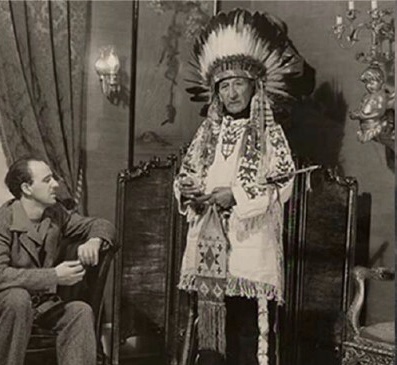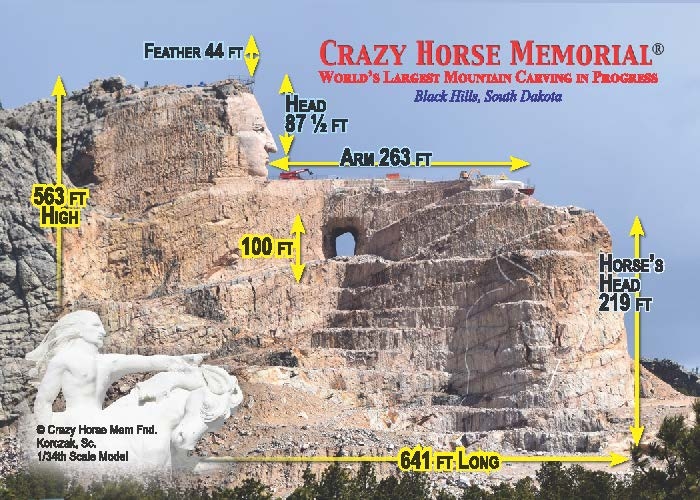President Donald J. Trump’s visit to Mount Rushmore reignited complaints from Native Americans that the land was stolen from them, and the monument desecrated land they regard as holy. This is true, but irreversible. We are not going to destroy the monument as the Taliban did to huge Buddhas. A different kind of settlement is required.

A few miles away from George Washington, Thomas Jefferson, Abraham Lincoln, and Teddy Roosevelt is another historical figure emerging from a mountain, one that dwarfs the presidents. Started more than 70 years ago, it is the monument to the great warrior Crazy Horse, and his people. This story first appeared in the Philadelphia Daily News on Aug. 5, 1988. It appears here with minor edits and with the acknowledgement that I have been a supporter of the Crazy Horse Memorial since that time.
HILL CITY, S.D. — Some people dream in color. Some people dream in black and white.
Gutzon Borglum and Korczak Ziolkowski were giants who dreamed in stone.
Their dreams were monumental, and they are unfinished.
Here in the Black Hills, their masterpieces complement each other as they applaud different aspects of the American character.
First, it was the dream of Borglum, a first-generation American of Danish stock, to carve a tableau of American freedoms as big as the land itself.
“Each succeeding civilization forgets its predecessor, and out of its body builds its homes, its temples,” he wrote. “Civilizations are ghouls . . . . “
He wanted to give his country “a few feet of stone that bears witness, carries the likenesses, the dates, a word or two of the great things we accomplished as a nation, placed so high it won’t pay to pull down for lesser purposes.”
For his “few feet of stone” he took a mountain – and created the Mount Rushmore National Memorial.
It wasn’t quick and it wasn’t easy. There was even loud opposition from some local folks….
He started the job in 1927 at the age of 60 and it was not finished when he died at the age of 74. As a matter of fact, it is not completed today, at least not as the artist had envisioned it. Work stopped when the nation went to war in 1941, and never resumed.
Even if you haven’t been here, it’s easy to picture the monument in your mind’s eye….
Many Americans got their first closeup view of the mammoth carving in Alfred Hitchcock’s “North by Northwest. ” Cary Grant was all over the monument.
Or so it seemed.
Those scenes actually were filmed using a special-effects model in a studio in Japan.
When you pull into the parking lot below the carving, it is a ways off and seems . . . small. Hold a quarter at arm’s length and the coin head of George Washington appears larger than the one on the mountain….
Borglum’s astonishing work is more impressive from the observation deck at the foot of the mountain. In the adjoining visitor center, you learn his plan was to carve not just heads, but torsos too.
To get the full impact of the size of his work, his skill – and the hardships he suffered – visit the Borglum Historical Center in nearby Keystone. The museum ($4.50 admission) has an actual-size replica of Lincoln’s eye, samples of Borglum’s other sculpture, plus equipment used for carving.
Most of the Rushmore work was done neither by chisel nor by drill, but by dynamite, using an ingenious technique devised by Borglum.

That dynamite technique was borrowed by Korczak Ziolkowski, a first-generation American of Polish descent, when he accepted an invitation from a group of North American Indians to carve a memorial to their people.
“My fellow chiefs and I would like the white man to know that the red man had great heroes, too,” Chief Standing Bear wrote to Ziolkowski.
The first thing you have to understand about Ziolkowski is that he was one hard-headed cuss.
A self-taught artist (his bust of Polish pianist Ignace Paderewski won a first prize in the 1939 World’s Fair), at age 34 he volunteered for military service and landed at Omaha Beach.
After the war, he came to the Black Hills to carve Crazy Horse – in the round – on Thunderhead Mountain, 17 miles from Mount Rushmore. Ziolkowski tackled the largest sculptural undertaking in history – a tableau dwarfing even the pyramids – completely alone.
When finished, the colossal work will depict the brilliant Oglala Lakota strategist on a pony, his arm extended, his hand pointing to Indian land. (“My lands are where my dead lie buried,” a defeated Crazy Horse answered a sarcastic white man who asked where Indian lands could be found.)
The finished figure will stand 563 feet high – eight feet taller than the Washington Monument.
We think of America’s Indian past as ancient history, but when a dynamite charge began the project on June 3, 1948, five of the nine Indian survivors of Custer’s Last Stand, the Battle of the Little BigHorn, were standing there.
Ziolkowski was able to work only five months a year because of bad weather, limited funds and limited help. Money and volunteers were always in short supply.
Twice the federal government offered this hard-headed cuss $10 million to finance the work. Each time, mindful of how a distracted, post-War government failed to complete Mount Rushmore, he said no.
He mentioned another federal promise, the one that pledged the sacred Black Hills would belong to the Native Americans for “as long as the rivers run, as long as the grasses grow and the trees bear leaves.”
“Well, when I got ready to do this monument, the Indians didn’t own the land,” he said. “The federal government did and I had to trade the Interior Department a parcel I owned elsewhere to get this particular piece. “
He never took a salary. He fell off the mountain several times, broke his back, had a heart attack. “Sometimes I wish I could change,” he said. “I’m a stubborn old bastard.”
He married a volunteer, Ruth Ross, and they raised 10 kids, eight of whom still work on the monument. He built a home, a museum, operated a dairy farm and a sawmill to raise funds.
On Oct. 20, 1982, the hard-headed cuss died at 74 – the same age as Borglum. Standing on the observation deck, it takes a couple of minutes to understand what the monument someday will be. Working from detailed plans left by her husband, Ruth is in charge now and she realizes, as did he, that it may not be finished in her lifetime.
Which is not the important thing.
The important thing is that the work continues so that – someday – not only will Crazy Horse be complete, but also the Indian museum, university and medical training center for Indians at its base, all envisioned by Ziolkowski.
MOUNT RUSHMORE DATA
The faces vary from 60 to 70 feet in height.
Each eye is eight feet in diameter.
The faces are proportioned to a man 465 feet tall.
A total of 450,000 tons of rock was removed.
Gutzon Borglum was not only a supporter of Roosevelt, but he resembled him, too. Legend has it that the face of Roosevelt looks like Borglum.
Annual visitors: 2 million.
Cost of the project: $980,000.
Admission: free
CRAZY HORSE
All four Mount Rushmore heads would fit inside Crazy Horse’s head.
The outstretched arm is 263 feet long on which 4,000 people could stand.
A 10-story building would fit beneath it.
When finished, the statue will be 563 feet high, 641 feet long.
HAPPY SUNDAY !!!
Nice work, pallie !
The Native American. Who wants to go first and admit that the white man TOOK what he wanted and created America.
In so doing, he almost annihilated the “real people”.
Two proud men carved a legacy that is unmatched. One for the whites, one for the “skin”. Both on Indian reservations, (sic) given to the tribes. The monuments should last forever, unless some loony tune succeeds in their destruction. The sad notes in history, is how things take place. Crazy Horse is on Pine Ridge reservation. That was probably the last battle that the Sioux fought and lost. Look it up. Mt Rushmore is on land “stolen” from the Sioux. As often happened, no treaty was signed or it was full of false promises. Arbitration still goes on for the “deed” to Mt Rushmore.
A fun fact. The “Boston Commons” was Pennobscott land because no treaty was signed. It took until the 1980s, I believe for the U.S. Supreme Court to finally force the federal government to “buy” the Boston Commons. Money and land was exchanged in favor of the tribe. I think that the Pennobscott eventually built a casino. That’s one way to screw the white man. Let him have fun loosing his money !
Tony
In some cases, Pennsylvania for one, the land was freely given or purchased. That was not the norm. Our treatment of the inhabitants was shameful.
Stu, my friend.
Please don’t insult my father’s people with such statements. “Freely given”. His people of the Cherokee nation got a really good deal! Let’s bring this into the present, this “freely given”. Go to a foreign country, where you don’t speak the language or understand the culture. Go make a deal. Let me know how you make out. You, my friend are in way over your head when you speak of the real people in this land, that is now called America.
Tony
The only person I will insult is he who reads carelessly. I said “in some cases.” Penn negotiated with Native Americans, wrote a treaty that was unbroken. I said that was not the norm.
Manhattan was “purchased’ for trinkets but the laugh was on the Europeans because Native Americans (like your father, I thought he was Japanese) believed they could not own land, so they “sold” that which they did not “own.”
Stu,
I read then reread your blog and reply. To think that an “uneducated savage” could comprehend a land swap or sale or trade is ridiculous to the umpth degree !
Many of the tribes, for some strange reason, welcomed the Europeans. Back beyond that, when the Vikings landed here, they got their heads handed to them by the Iroquois. The term “own land” was unique to most of the tribes. We owned horses not land. We occupied it as a family (tribe ).
Getting off the beaten path. This is what is wrong when whites try to think like a black person. We have no idea……………
Now pallie. Where the hell did you get the idea that my father was Japanese? Not all short people are from the orient. Particularly the ones with curly hair and look like an Indian, but you two never met, so you wouldn’t know that.
stay well
Tony
The same place I got the idea your father was an Indian. I have no idea what point you ate trying to make, but it fails.
And you have a disturbingly negative image of Indians if you think they don’t understand a swap.
I may not have made myself perfectly clear, but you didn’t get that I idea from me. I mentioned the fact of Japanese internment in comparison to the way that this country treated the Indian.
Because I knew people of the five nations as well as other tribes, I had a fairly good understanding of what was done and what was taking place. The Cherokee that were left on the east coast survived by adopting the ways of the settlers. Meaning, they gave up their ways. The Lenni Lenape, who Penn screwed, folded completely. They went from hunters to farmers in blending with the English. You can call that “understanding a swap”. No Native American that I know will ever agree with you.